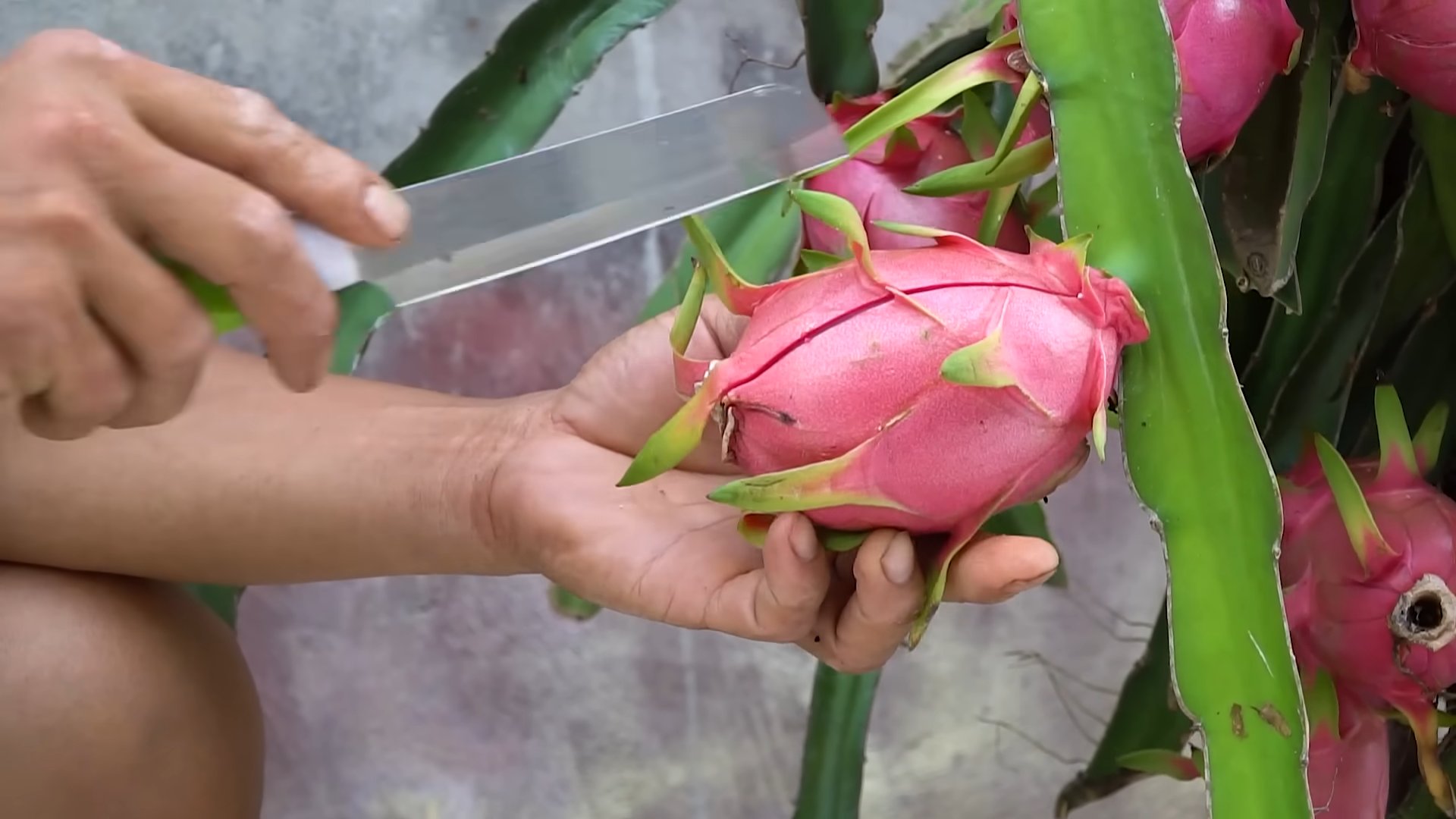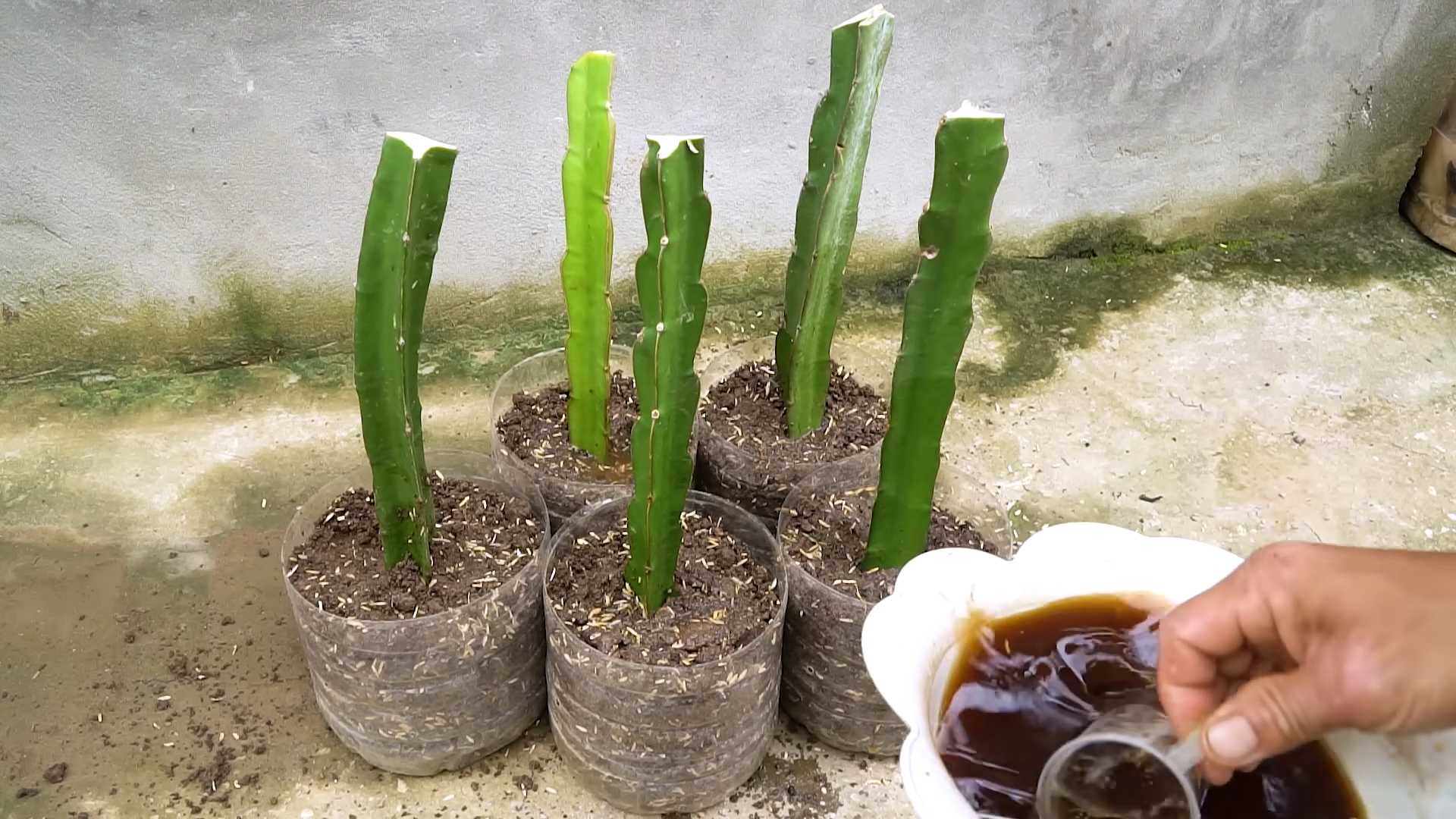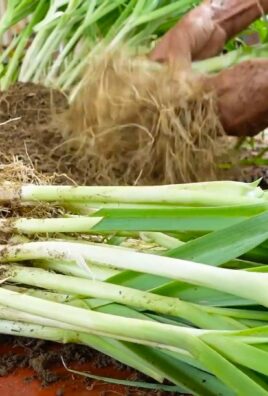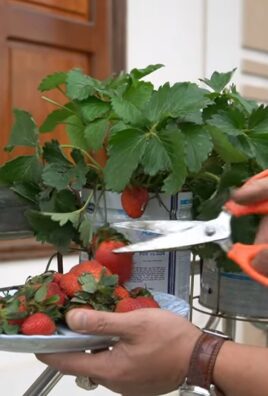Grow dragon fruit at home? Absolutely! Imagine plucking a vibrant, exotic dragon fruit straight from your own backyard. Sounds like a tropical dream, right? Well, it’s more attainable than you think! For centuries, dragon fruit, also known as pitaya, has been a cherished fruit in Southeast Asia and Latin America, revered not only for its unique flavor but also for its stunning appearance. Its vibrant colors and intriguing texture have made it a symbol of prosperity and good fortune in many cultures.
But why should you embark on this exciting gardening adventure? Let’s face it, store-bought dragon fruit can be expensive and sometimes lacks the fresh, vibrant flavor you crave. Plus, there’s something incredibly rewarding about nurturing a plant from a small cutting to a fruit-bearing beauty. I’m here to guide you through some simple yet effective DIY tricks and hacks that will empower you to grow dragon fruit at home, even if you’re a beginner gardener. Get ready to transform your garden into a tropical paradise and enjoy the sweet rewards of your labor!

Growing Dragon Fruit at Home: A Comprehensive DIY Guide
Hey there, fellow plant enthusiasts! Ever dreamt of having your own exotic dragon fruit hanging from a vine in your backyard? Well, dream no more! Growing dragon fruit at home is totally achievable, even if you don’t have a green thumb the size of Texas. I’m going to walk you through everything you need to know, from choosing the right cutting to harvesting your delicious, homegrown fruit. Let’s get started!
Choosing Your Dragon Fruit Variety
First things first, you need to decide which dragon fruit variety you want to grow. There are tons of options, each with its own unique flavor, color, and size. Here are a few popular choices:
* White-fleshed varieties (e.g., Hylocereus undatus): These are the most common and often the easiest to find. They have a mild, slightly sweet flavor.
* Red-fleshed varieties (e.g., Hylocereus costaricensis): These are known for their vibrant red flesh and slightly tart flavor. They’re also packed with antioxidants!
* Yellow-fleshed varieties (e.g., Selenicereus megalanthus): These are the sweetest of the bunch and have a unique, almost floral flavor. They’re a bit harder to find, but totally worth the effort.
* Self-pollinating varieties: Some varieties, like ‘American Beauty’ and ‘Purple Haze’, are self-pollinating, meaning you only need one plant to get fruit. This is a huge plus if you’re short on space or just want to keep things simple.
Once you’ve chosen your variety, you’ll need to get your hands on a cutting. You can usually find these at local nurseries, online retailers, or even from a friend who already grows dragon fruit. Just make sure the cutting is healthy and at least 12 inches long.
Preparing Your Dragon Fruit Cutting
Okay, you’ve got your cutting! Now it’s time to get it ready for planting. This is a crucial step, so pay close attention.
1. Let the cutting callous: This is super important! Before planting, you need to let the cut end of the cutting dry out and form a callous. This helps prevent rot. Simply place the cutting in a dry, shaded area for about 1-2 weeks. You’ll notice the cut end will start to harden and form a protective layer.
2. Prepare your potting mix: Dragon fruit needs well-draining soil. A good mix is equal parts potting soil, perlite, and coarse sand. This will ensure that the roots don’t sit in water, which can lead to root rot.
3. Choose your pot: Select a pot that’s at least 10-12 inches in diameter. Dragon fruit plants can get quite large, so you’ll eventually need to transplant them into a larger pot or directly into the ground. Make sure the pot has drainage holes!
Planting Your Dragon Fruit Cutting
Alright, let’s get this cutting in the ground!
1. Fill the pot with your potting mix: Leave a few inches of space at the top of the pot.
2. Plant the cutting: Insert the calloused end of the cutting about 2-3 inches into the soil. You can use a chopstick or pencil to create a hole first to avoid damaging the cutting.
3. Water gently: Water the soil lightly until it’s moist but not soggy.
4. Provide support: Dragon fruit is a climbing cactus, so it needs support to grow. You can use a stake, trellis, or even a sturdy post. Place the support near the cutting and gently tie the cutting to it with soft twine or plant ties.
Caring for Your Dragon Fruit Plant
Now that your dragon fruit is planted, it’s time to give it the TLC it needs to thrive.
1. Sunlight: Dragon fruit loves sunlight! Aim for at least 6-8 hours of direct sunlight per day. If you’re growing it indoors, place it near a sunny window or use a grow light.
2. Watering: Water your dragon fruit plant when the top inch of soil feels dry. Avoid overwatering, as this can lead to root rot. During the growing season (spring and summer), you’ll need to water more frequently than in the dormant season (fall and winter).
3. Fertilizing: Feed your dragon fruit plant with a balanced fertilizer (e.g., 10-10-10) every 2-3 months during the growing season. You can also use a fertilizer specifically formulated for cacti and succulents.
4. Pruning: Pruning is important for shaping your dragon fruit plant and encouraging fruit production. Remove any dead or damaged branches. You can also prune back the plant to control its size and shape. The best time to prune is after the plant has finished fruiting.
5. Pest and disease control: Dragon fruit plants are generally resistant to pests and diseases, but they can sometimes be affected by mealybugs, aphids, or fungal infections. Inspect your plant regularly for any signs of problems. If you find any pests, you can try spraying them with insecticidal soap or neem oil. For fungal infections, you can use a fungicide.
6. Temperature: Dragon fruit thrives in warm temperatures (65-80°F). It can tolerate temperatures as low as 32°F for short periods, but it’s best to protect it from frost. If you live in a cold climate, you can grow your dragon fruit in a pot and bring it indoors during the winter.
Pollinating Your Dragon Fruit Flowers
Dragon fruit flowers are absolutely stunning! They’re large, white, and fragrant, and they only bloom at night. However, most varieties require cross-pollination to produce fruit. This means you’ll need to hand-pollinate the flowers yourself, unless you have bats or moths in your area to do the job for you.
1. Identify the male and female parts: The male part (stamen) is covered in pollen, while the female part (pistil) has a sticky stigma in the center.
2. Collect pollen: Use a small brush or cotton swab to collect pollen from the stamen of one flower.
3. Transfer pollen: Gently transfer the pollen to the stigma of another flower.
4. Repeat: Repeat this process for all the open flowers on your plant.
5. Timing: The best time to hand-pollinate is at night, when the flowers are fully open.
If you have a self-pollinating variety, you can still hand-pollinate to increase your chances of getting fruit.
Harvesting Your Dragon Fruit
After pollination, it takes about 30-50 days for the fruit to ripen. Here’s how to know when it’s ready to harvest:
1. Color change: The skin of the fruit will change from green to bright red, pink, or yellow, depending on the variety.
2. Slight give: The fruit should feel slightly soft to the touch.
3. Easy to detach: The fruit should easily detach from the stem when you twist it gently.
To harvest, simply twist the fruit off the stem. Be careful not to damage the plant.
Troubleshooting Common Problems
Even with the best care, you might encounter some problems along the way. Here are a few common issues and how to fix them:
* Yellowing leaves: This could be a sign of overwatering, underwatering, or nutrient deficiency. Check the soil moisture and adjust your watering accordingly. You can also try fertilizing your plant with a balanced fertilizer.
* Root rot: This is caused by overwatering and poor drainage. If you suspect root rot, carefully remove the plant from the pot and inspect the roots. If the roots are brown and mushy, cut them off with a clean knife. Repot the plant in fresh, well-draining soil.
* Lack of fruit: This could be due to a lack of pollination, insufficient sunlight, or nutrient deficiency. Make sure you’re hand-pollinating your flowers if necessary, and provide your plant with plenty of sunlight and fertilizer.
* Pests: Mealybugs and aphids can sometimes infest dragon fruit plants. Spray them with insecticidal soap or neem oil.
Training Your Dragon Fruit Vine
Dragon fruit vines can grow quite long and unruly if left unchecked. Training them properly is essential for maximizing fruit production and keeping your plant manageable.
1. Establish a strong support structure: A sturdy trellis, post, or even a large tree can serve as a support. The support should be able to withstand the weight of the mature vine and the fruit.
2. Guide the main stem: As the main stem grows, gently tie it to the support using soft plant ties or twine. Encourage it to grow vertically.
3. Encourage branching: Once the main stem reaches the top of the support, you can prune it to encourage branching. This will create more

Conclusion
So, there you have it! Growing dragon fruit at home is not only achievable, but it’s also a deeply rewarding experience. Forget those expensive, often bland, store-bought fruits. Imagine plucking a vibrant, sweet, and juicy dragon fruit straight from your own backyard or balcony. This DIY project transforms your space into a mini-tropical oasis and provides you with a sustainable source of deliciousness.
Why is this a must-try? Because it’s more than just growing fruit; it’s about connecting with nature, learning new skills, and enjoying the fruits (literally!) of your labor. It’s about knowing exactly where your food comes from and reducing your carbon footprint. Plus, the stunning beauty of the dragon fruit plant itself, with its unique climbing structure and nocturnal blooms, adds an exotic touch to any garden.
Don’t be afraid to experiment! Consider these variations to personalize your dragon fruit growing journey:
* Different Varieties: Explore different dragon fruit varieties beyond the common red-fleshed type. White-fleshed, yellow-skinned, and even pink-fleshed varieties offer unique flavors and textures. Research which varieties thrive best in your climate.
* Support Structures: While a sturdy trellis is the standard, get creative with your support system. Use repurposed materials like old tires, metal pipes, or even a creatively designed wooden structure. Ensure it’s strong enough to support the weight of a mature plant.
* Grafting: For faster fruit production, consider grafting your desired dragon fruit variety onto a more established rootstock. This technique can significantly reduce the time it takes for your plant to bear fruit.
* Hydroponics: If you’re short on space or prefer a soilless approach, explore hydroponic dragon fruit cultivation. This method allows for precise control over nutrient delivery and can be highly efficient.
We understand that embarking on a new gardening adventure can be daunting, but we assure you that growing dragon fruit at home is more accessible than you might think. With a little patience, the right information, and a touch of dedication, you’ll be harvesting your own delicious dragon fruit in no time.
We wholeheartedly encourage you to give this DIY trick a try. Start small, learn as you go, and don’t be afraid to make mistakes. The journey is just as rewarding as the destination.
And most importantly, we want to hear about your experiences! Share your successes, your challenges, and your tips in the comments below. Let’s build a community of dragon fruit enthusiasts and learn from each other. Your insights could inspire others to embark on their own dragon fruit growing adventures. So, grab your cuttings, prepare your soil, and get ready to experience the joy of growing dragon fruit at home! Let us know how your **grow dragon fruit at home** project turns out!
Frequently Asked Questions (FAQ)
1. What is the best climate for growing dragon fruit?
Dragon fruit thrives in warm, tropical, and subtropical climates. Ideally, temperatures should range between 65°F (18°C) and 80°F (27°C). They can tolerate short periods of cooler temperatures, but prolonged exposure to frost will damage or kill the plant. If you live in a colder climate, consider growing dragon fruit in containers that can be moved indoors during the winter months. Greenhouses are also a viable option for extending the growing season.
2. What kind of soil is best for dragon fruit?
Dragon fruit prefers well-draining soil that is slightly acidic to neutral (pH 6.0-7.0). Avoid heavy clay soils that retain too much water, as this can lead to root rot. A good soil mix would include a combination of potting soil, perlite, and compost. The perlite improves drainage, while the compost provides essential nutrients. You can also add a small amount of sand to further enhance drainage. When planting in containers, ensure that the pot has drainage holes to prevent waterlogging.
3. How much sunlight does dragon fruit need?
Dragon fruit needs at least 6-8 hours of sunlight per day to thrive. However, young plants can be susceptible to sunburn, so it’s best to provide them with some afternoon shade, especially in hot climates. Mature plants can tolerate full sun, but they will still benefit from some protection during the hottest part of the day. If growing indoors, place your dragon fruit plant near a sunny window or supplement with grow lights.
4. How often should I water my dragon fruit plant?
Water dragon fruit plants regularly during the growing season, keeping the soil consistently moist but not waterlogged. Allow the top inch of soil to dry out between waterings. Reduce watering during the dormant season (winter). Overwatering is a common mistake that can lead to root rot, so it’s always better to err on the side of underwatering. The frequency of watering will depend on factors such as climate, soil type, and pot size.
5. What kind of fertilizer should I use for dragon fruit?
Dragon fruit benefits from regular fertilization during the growing season. Use a balanced fertilizer (e.g., 10-10-10) every 2-3 weeks. You can also supplement with organic fertilizers such as compost tea or worm castings. Avoid over-fertilizing, as this can burn the roots. During the flowering and fruiting stages, switch to a fertilizer with a higher phosphorus content to promote fruit development.
6. How long does it take for dragon fruit to bear fruit?
Dragon fruit plants typically start bearing fruit within 1-3 years of planting, depending on the variety and growing conditions. Grafted plants may produce fruit sooner. To encourage fruiting, ensure that your plant receives adequate sunlight, water, and fertilizer. Hand-pollination may be necessary if there are no natural pollinators in your area. Dragon fruit flowers bloom at night and are pollinated by bats and moths.
7. How do I pollinate dragon fruit flowers?
Dragon fruit flowers are hermaphroditic, meaning they have both male and female reproductive parts. However, some varieties are self-sterile and require cross-pollination from another variety to produce fruit. To hand-pollinate, use a small brush to transfer pollen from the stamen (male part) of one flower to the stigma (female part) of another flower. The best time to pollinate is at night when the flowers are fully open.
8. What are some common pests and diseases that affect dragon fruit?
Common pests that affect dragon fruit include aphids, mealybugs, and scale insects. These pests can be controlled with insecticidal soap or neem oil. Root rot is a common disease that can occur if the soil is poorly drained or the plant is overwatered. To prevent root rot, ensure that your plant is grown in well-draining soil and avoid overwatering. Other diseases that can affect dragon fruit include stem rot and fungal infections.
9. How do I prune dragon fruit plants?
Pruning is essential for maintaining the shape and health of dragon fruit plants. Prune regularly to remove dead or damaged stems, as well as any stems that are growing in the wrong direction. You can also prune to control the size and shape of the plant. The best time to prune is after the fruiting season. Use clean, sharp pruning shears to avoid spreading diseases.
10. Can I grow dragon fruit in a container?
Yes, dragon fruit can be successfully grown in containers, making it a great option for those with limited space. Choose a large container (at least 20 gallons) with drainage holes. Use a well-draining potting mix and provide a sturdy trellis or support structure for the plant to climb on. Container-grown dragon fruit plants may require more frequent watering and fertilization than those grown in the ground.




Leave a Comment